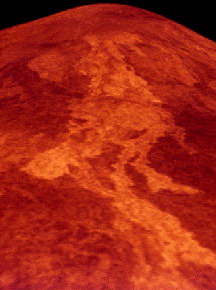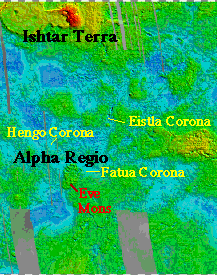This is an image of Venus.
Click on image for full size
NASA
Does Venus Have a Surface in Motion?
Like Mars, there is no continental drift on the surface of Venus. The surface of Venus does not *seem* to have changed or moved in billions of years. Nevertheless, there are a few signs which suggest that the surface may be in motion.
You might also be interested in:

What types of instructional experiences help K-8 students learn science with understanding? What do science educators teachers, teacher leaders, science specialists, professional development staff, curriculum designers, school administrators need to know to create and support such experiences?
...more
Unlike Earth, there is no continental drift on Mars today. The Martian surface does not seem to have changed or moved in billions of years. 1.) The surface of Mars shows craters at all latitudes and longitudes.
...more
This is a map of the surface of Venus (turned sideways!). As can be seen on the map, there is no ocean, but there are highlands and lowlands. Lowlands in the map can be thought of as like the ocean bottom,
...more
Let's look at the evidence: Mercury Venus The Moon Mars Io Europa Ganymede Callisto Triton Miranda What about Jupiter, Saturn, Uranus, Neptune, Titan, or Pluto? These planets or moons either have no surface,
...more
This is an example of the craters of Venus. Venus seems to have about 900 craters, which is about the same number of craters found on the surface of the Earth. Since we know that the Earth has an active
...more
The Earth-planets formed with the gathering of rocky material and volatiles out of the primitive solar nebula. As they finished forming, the surface continued to be hit by the remnant of planetary material
...more
Unlike the Earth's crust, the crust of Venus is very rigid. The shape of the volcanoes suggests that over its history, Venus, like Mars, has built a thick crust. A thick crust prevents motions of a surface.
...more
Alpha Regio is the home of Eve Mons, a volcano.
...more














